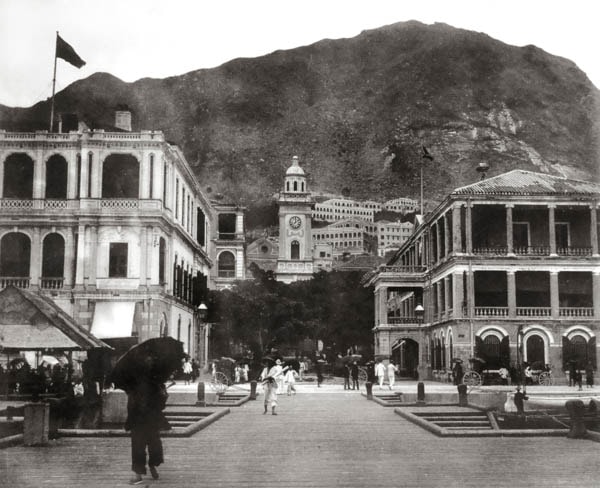Jardine Matheson & Co.
Jardine Matheson & Co., often referred to as the Princely Hong, was founded by William Jardine, a former surgeon with the East India Company, and James Matheson, a Scottish merchant in 1832. It soon made vast profits through the sale of opium.[28]
After the East India Company’s trade monopoly ended in 1834, the company became one of the leading British firms in China. William Jardine soon retired and returned to Britain. He was among the group of British merchants who lobbied the British Government to settle the opium dispute by force and to take the island of Hong Kong. The headquarters of Jardine Matheson & Co. moved to Hong Kong after it had purchased lots at East Point (a large area in the vicinity of present-day Causeway Bay, basically Paterson Street and Yee Wo Street) at the first land sale to build its offices, piers and godowns.
Between 1842 and 1860 the firm expanded and consolidated its position. Meanwhile, branches were opened in each of the treaty ports, and it operated its own fleet of clippers, trading mainly in opium and tea.
By the 1870s, it ceased to trade in opium, and branched off into a variety of enterprises, including sugar refining, spinning and weaving textiles, and steam railways. It continued to be one of the leading firms in Hong Kong during the 20th century, and Jardine Matheson’s taipans were prominent figures in the colony, many serving as members of the Legislative Council. Consequently, there are many streets in Causeway Bay named after them: Yee Wo Street, Jardine’s Bazaar, Matheson Street, Irving Street, Percival Street and Paterson Street, just to name a few.
Dent & Co.
Dent & Company was founded by William Dent, a pioneer of China trade in Guangzhou in the late 18th century.[29] Under the leadership of his three sons, John, Lancelot and Wilkinson, the company grew to become a leading firm in Guangzhou. Dealing mainly in opium and tea, it was the main competitor of Jardine Matheson & Co. in the 1830s. It moved its headquarters to Hong Kong after it had purchased lots in Central at the first land sale. In the 1840s and 1850s, Dent’s was a well-established firm dealing in exports and imports, and served as an agency for several firms. It was also associated with the Hongkong and Shanghai Bank’s establishment. However, it failed to survive a serious depression and closed down in 1867.
Butterfield and Swire
Butterfield and Swire (B&S) was founded by John Swire and Richard Butterfield in Shanghai in 1866, and dealt mainly in the importation of tea and silk.[30] It moved its headquarters to Hong Kong in 1870. Branch offices were opened first in Yokohama and then in Fuzhou. More branches were established in many of the treaty ports in the following years. The B&S underwent significant development and expansion in the 1880s, with the founding of the Taikoo Sugar Refinery Company, the China Navigation Company, and the Taikoo Dockyard and Engineering Company. It served as agent in China and Japan for the Ocean Steamship Company and the China Mutual Steam Navigation Company. By the end of the 19th century, the B&S had become a leading firm in Hong Kong and China.
Russell & Co.
Founded in 1818 by Samuel Russell of Boston, Russell & Co. was one of the oldest American firms in China.[31] The firm first traded purely as an agency, but after a reorganisation in 1830, it became one of the biggest American firms in the Far East. Russell & Co. established its branch in Hong Kong in 1850. By 1861, it had seven partners in Hong Kong, Shanghai, Guangzhou and Fuzhou. Its business included imports and exports, insurance, general shipping and rope work. It also operated a ferry service between Hong Kong and Guangzhou. In 1895 the firm was completely reorganised and was renamed Shewan, Tomes & Co.
Notes:
- [28]Solomon Bard, Traders of Hong Kong: Some Foreign Merchant Houses, 1841-1899, pp. 65-68; Arnold Wright, Twentieth Century Impressions of Hong Kong : History, People, Commerce, Industries and Resources, pp. 210-211.
- [29]Solomon Bard, Traders of Hong Kong: Some Foreign Merchant Houses, 1841-1899, pp. 56-57.
- [30]Solomon Bard, Traders of Hong Kong: Some Foreign Merchant Houses, 1841-1899, pp. 54-56; Arnold Wright, Twentieth Century Impressions of Hong Kong : History, People, Commerce, Industries and Resources, p. 211.
- [31]Solomon Bard, Traders of Hong Kong: Some Foreign Merchant Houses, 1841-1899, pp. 82-83.



